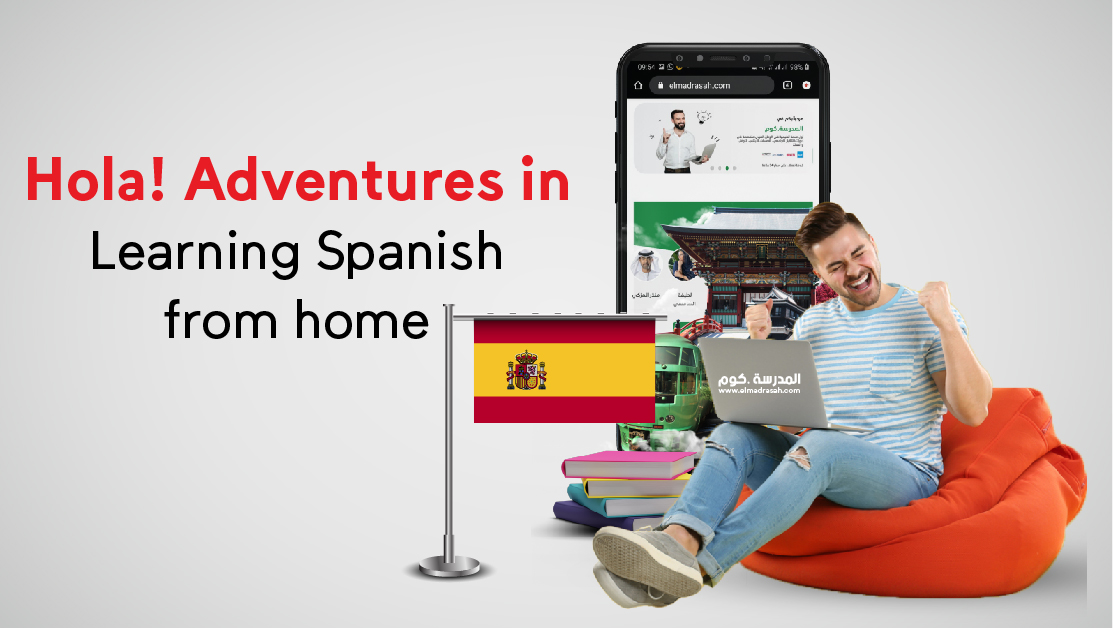
¡Hola! Are you looking to add a new language to your skillset? Look no further than Spanish! With its rich culture, beautiful music, and delicious food, learning Spanish can open up a whole new world of opportunities. And the best part? You can do it all from the comfort of your own home! In this blog post, we’ll take you on an adventure through the basics of learning Spanish conversation and give you tips on how to start learning easily from home. So grab a cup of café con leche and let’s get started on our ¡Hola! Adventures in Learning Spanish from Home.
How to start learning spanish ?
If you’re interested in learning Spanish from home, the first thing to consider is your motivation. Why do you want to learning Spanish ? Whether it’s for personal or professional reasons, having a clear goal will help keep you motivated and focused.
Once you’ve established your motivation, start by familiarizing yourself with the basics of the language. Practice greeting people with “Hola” (hello) and introducing yourself with “Me llamo” (my name is). These simple phrases can go a long way in helping you feel more comfortable speaking Spanish.
Next, invest in some quality learning resources that fit your learning style. There are many online courses, apps, and textbooks available that cater to different preferences. Find what works best for you and commit to regular practice sessions.
Another effective method for language learning is immersion through media consumption. Watch TV shows or movies in Spanish with English subtitles or listen to podcasts entirely in learning Spanish while following along with transcripts.
Practice consistently but don’t be afraid of making mistakes. Learning a new language takes time and effort but staying committed will pay off over time as fluency increases gradually!
The basics: Greetings and introductions
Learning the basics of Spanish greetings and introductions is essential when starting your language journey. These simple phrases can help you connect with Spanish speakers and make a positive impression.
Firstly, it’s important to understand the difference between formal and informal greetings. In Spain, “Hola” (hello) is commonly used for both formal and informal situations, but in Latin America, there are different phrases depending on the context. For example, “Buenos días” (good morning) or “Buenas tardes” (good afternoon) are more formal than simply saying “Hola”.
When meeting someone for the first time, it’s common to introduce yourself by saying “Me llamo…” followed by your name. Alternatively, you could say “Soy…” which means “I am”. It’s also polite to ask someone their name by saying “¿Cómo te llamas?” which translates to “What is your name?”
Another important aspect of introductions is addressing people correctly based on their gender and social status. In Spanish culture, titles such as Señor (Mr.), Señora (Mrs.) or Señorita (Miss) are often used before a person’s last name as a sign of respect.
Mastering basic greetings and introductions in Spanish will set you up for success when communicating with native speakers both formally and informally. With practice and dedication towards learning new vocabulary words each day through online courses or mobile applications available at affordable rates nowadays ensures that anyone can learn this beautiful language easily from home!
Getting around: Asking for directions
When traveling to a Spanish-speaking country, getting around can be quite challenging, especially if you are not familiar with the area. The good news is that asking for directions in Spanish is simple and easy.
Firstly, it’s important to know some basic vocabulary such as “calle” meaning street and “esquina” meaning corكجزطner. When approaching someone for directions, start by saying “Disculpe,” which means excuse me. Then ask “¿Dónde está la calle…?” to ask where a specific street is located.
If you’re trying to locate a landmark or tourist attraction, try using phrases like “¿Cómo llego al…” (How do I get to…) or “¿Dónde queda el…” (Where is the…) followed by the name of your destination.
It’s also helpful to know cardinal directions such as north (“norte”), south (“sur”), east (“este”) and west (“oeste”). You could say something like “¿Hacia qué dirección está…?” which means what direction is…?
Remember that when asking for help always show gratitude by saying thank you at the end of your conversation. With these simple phrases and words in mind, navigating through any Spanish speaking city will be much easier!
At the restaurant: Ordering food and drink
At the restaurant, ordering food and drink is an essential part of learning Spanish. Knowing how to communicate with the waiter or waitress can make a difference in your dining experience.
First, it’s important to know some basic vocabulary. “Una mesa para dos, por favor” means “A table for two, please.” When it comes to ordering drinks, “Quiero un vaso de agua” is a simple way to ask for water. If you prefer something else, try “Me gustaría una bebida sin alcohol,” which means “I would like a non-alcoholic beverage.”
When it comes time to order your meal, there are many phrases that can come in handy. Start by asking for a menu: “¿Puedo tener el menú por favor?” Then take note of any dishes that catch your eye and don’t be afraid to ask questions about the ingredients.
If you have any special dietary requirements or allergies, make sure you inform the waiter or waitress before placing your order. You might say something like “Soy alérgico/a al gluten” (“I am allergic to gluten”) or “No como carne” (“I don’t eat meat”).
Remember to thank your server when they bring out each course: “Gracias,” will suffice! By practicing these phrases at home before heading out for dinner en español , you’ll be well on your way towards mastering Spanish language skills while enjoying delicious cuisine!
Shopping: Buying groceries and souvenirs
Shopping for groceries and souvenirs can be a fun way to practice your Spanish while immersing yourself in the culture. In Spain, there are many local markets where you can find fresh produce, meats, cheeses and more. It’s a great opportunity to interact with locals and learn new vocabulary related to food.
When shopping for souvenirs, it’s important to know basic phrases like “¿Cuánto cuesta?” (How much does it cost?) and “¿Tiene algo más económico?” (Do you have anything cheaper?). Bargaining is common in some markets so don’t be afraid to negotiate prices.
Visiting smaller cities or towns can also offer unique shopping experiences. You may stumble upon artisanal items such as handmade pottery or textiles that are not typically found in tourist areas.
Don’t forget about online shopping options as well! There are plenty of websites offering traditional learning Spanish products from jamón ibérico to flamenco dresses. This can be a good option if you’re unable to travel or looking for something specific.
Shopping in Spain offers an exciting opportunity to practice your Spanish skills and experience the local culture firsthand.
In the classroom: Learning Spanish verbs
Learning Spanish verbs can be a bit challenging, but with the right approach and resources, it can become easier. The first step to mastering Spanish verbs is understanding what they are and how they work. Verbs are action words that describe what someone or something is doing or feeling.
One way to learn Spanish verbs is through memorization. There are many different verb tenses in learning Spanish, so it’s important to start by memorizing the present tense of common verbs like “hablar” (to speak), “comer” (to eat), and “vivir” (to live). Once you have these basic verbs down, you can move on to conjugating them in other tenses.
Another way to learn Spanish verbs is through practice exercises. You can find plenty of online resources that offer interactive quizzes and games designed specifically for learning Spanish grammar and verb usage.
It’s also helpful to immerse yourself in the language as much as possible by reading books, watching movies or TV shows in Spanish with subtitles or listening to podcasts from native speakers.
In summary, there are many effective ways for learning Spanish verbs including memorization, practice exercises and immersion techniques. By taking advantage of these methods consistently over time, you’ll be well on your way towards mastering this essential aspect of the language!
On vacation: Talking to locals
When traveling to a Spanish-speaking country, it’s essential to know some basic phrases that will help you communicate with the locals. Whether you’re asking for directions or ordering food at a restaurant, being able to speak Spanish can make your trip more enjoyable and memorable.
One of the best ways to practice your conversational skills is by talking to locals during your vacation. Strike up a conversation with someone in a park or café and ask them about their favorite local attractions or restaurants. You might discover hidden gems that are off the beaten path!
If you’re not confident in your speaking abilities, don’t be afraid to start with simple greetings like “Hola” (hello) or “Buenos días” (good morning). Many people appreciate tourists who make an effort to speak their language, even if it’s just a few words.
Another helpful tip is to listen carefully when locals speak and try to pick up on common phrases and expressions. This can not only improve your understanding but also show respect for their culture.
Talking with locals can be one of the most rewarding experiences while on vacation in a Spanish-speaking country. It allows you to learn from authentic sources and gain insights into the local way of life that guidebooks simply cannot provide.















